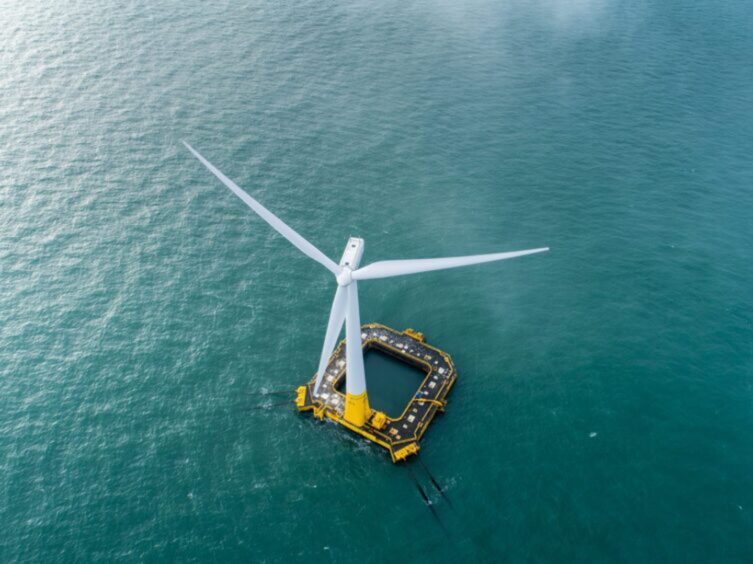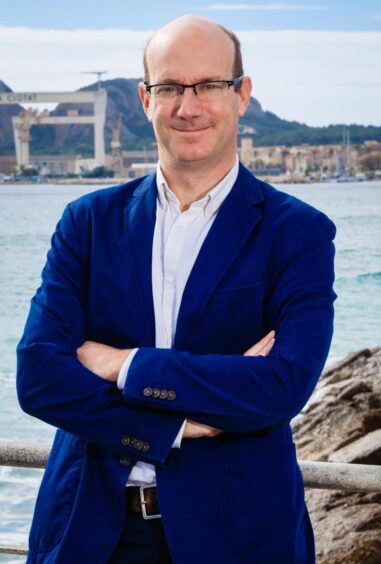
BW Ideol’s highland manufacturing base for offshore wind floaters provides the opportunity for operators to create “local economic benefits” while achieving the energy transition, the firm’s boss told Energy Voice.
Paul de la Guérivière, chief executive of BW Ideol, explained that his Ardersier base is planning on establishing a “dedicated production line.”
He said: “We have done a deal with the port where we will put in place the production line that can deliver close to gigawatt per year so you are not dependent on external yards that are serving other customers and other industries.
“You have full control of the way that you are going to manufacture, you have control over the quality, and you can demonstrate to the government that with this activity you will create jobs locally.”
In addition to supporting Scottish jobs, the base in the highlands offers firms the opportunity to “create local benefits,” the BW Ideol chief executive explained.
In 2021 the Floating Energy Allyance – a partnership including BayWa r.e., Elicio and BW Ideol –shared that its bid in the ScotWind leasing process could create 3,900 jobs in Scotland.
For BW Ideol’s highlands base alone it is estimated that up to 2,000 people will be onsite during peak production, with one floater produced per week.
The necessity of domestic manufacturing
In Paul de la Guérivière’s opinion, domestic manufacturing of floaters for offshore wind is not just a nice addition to a project, it is a necessity if targets are to be met.
“The only way to deliver one gigawatt is to have concrete manufacturing in Europe or the other arguments are not valuable for large-scale projects,” he explained.
BW Ideol’s solution is to manufacture concrete foundations for floating wind projects in the highlands.
Mr Guérivière argues that his firms’ floaters are “much more compact” and have a “much shallower draft” than other options in the market.
This allows the infrastructure to fit in British ports, as he explains: “We don’t need deep ports and dedicated infrastructure with the high upfront investment cost in comparison to the semisub design.”
He added: “In Scotland, there are floaters with steel that was not manufactured in Scotland or even in the UK, they were manufactured in Spain.”
Referring to the Kincardine floating wind farm off the coast of Aberdeen, he explained that despite the relatively low number of floaters needed for the project “they still had to manufacture outside of the UK.”
The BW Ideol boss argued” If for three or five units you can’t do it in the UK, you can imagine that for a one gigawatt project with 60 units, it’s never going to materialise. No matter what you say, its a fiction.”
Because of this, Paul de la Guérivière sees only one solution to create value while delivering the UK’s 5GW of floating wind targets by 2030.
Mr Guérivière explained: “So the only way to effectively be able to commit and to demonstrate local value creation is to add floaters and concrete.”
Standardisation to help UK floating wind roll-out
There are a number of hoops perspective floating wind developers must jump through in order to achieve their goal of putting turbines on the water.
One problem is deciding on a floater design and where to have it manufactured, this is part of the reason standardisation is a much-discussed topic in the space.
Mr Guérivière said: “To make a comparison to make it easier to explain, if you were to buy a wind turbine as you are currently buying a floater, first you would have to go to a wind turbine manufacturer and you would have to pay for engineering for two years with no visibility on where it is going to be manufactured, no visibility on the final price or on the technical performance.”
The BW Ideol boss explained that “after two years you have a price but you still have no visibility” on where manufacturing will take place.
To overcome this BW Ideol’s strategy is to allow developers to buy the floater in the same way they can currently purchase wind turbines in order to streamline the process.
The firm is looking to manufacture “a product that is generally the same, you may have sme adaptation depending on the site and the project… but apart from that most of the components are the same,” Mr Guérivière said.
However, Ole Stobbe, business development manager for northern Europe at BW Ideol, has previously called for a Darwinism-based approach over standardisation in the floating wind space.
Darwinism refers to the theory of evolution and how beneficial traits in a species will present themselves as less beneficial factors that are abandoned over time.
Speaking at last year’s floating offshore wind conference Mr Stobbe said: “One problem with that is standardisations is a democratic process which is being run by experts and they agree on standards, codes, rules, et cetera.
“But these experts are normally recruited from those people who manufacture what they want to standardise.
“Once the standards are established, innovation has a really hard time to move through the standardisation because the incumbents obviously have an interest to make it difficult for innovations to come through that might risk their business model.”
‘We have a proven and bankable technology’
Mr Guérivière disagrees with the sentiment of his business development manager for northern Europe, saying: “It’s impossible just to set up a supply chain for just one single project.”
He explained: “We have a proven and bankable technology. There are a lot of potential concepts, but it the end, if you want to deliver the gigawatts of projects that are under development in Scotland, or potentially after in the North Sea, you need proven technologies.”
Paul de la Guérivière says that if a firm wants to deliver a one-gigawatt project it will “raise €3 billion as debt” something that he claims, “no financial institution bank” will back unless the proposed technology has been “in the water for many years.”
Ultimately, the firm is bringing this proven technology to the Scottish highlands to create local economic benefits and allow North Sea floating wind developers to manufacture floaters domestically.
Recommended for you

 © Supplied by Haventus
© Supplied by Haventus © Supplied by Ardersier Port
© Supplied by Ardersier Port